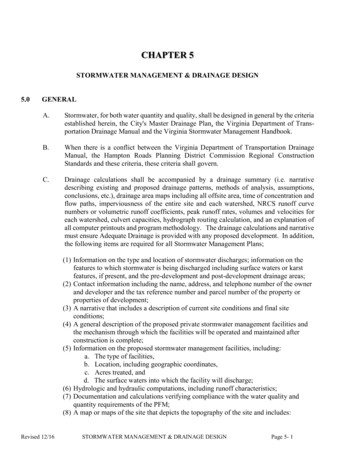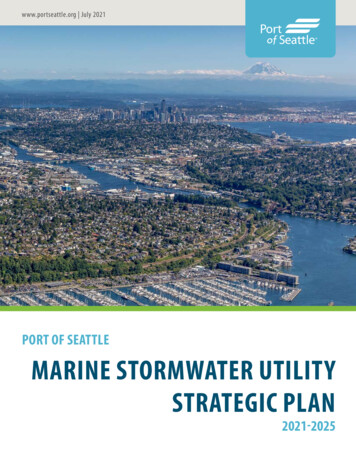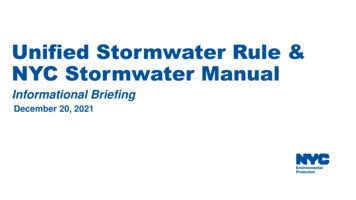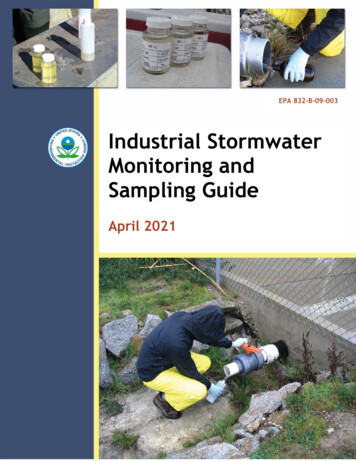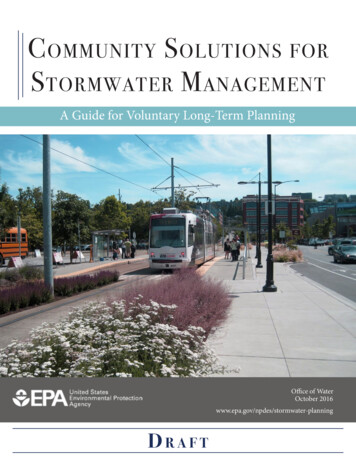
Transcription
C ommunity S olutions forS tormwater M anagementA Guide for Voluntary Long-Term PlanningOffice of WaterOctober 2016www.epa.gov/npdes/stormwater-planningDraft
The purpose of this guide is to assist EPA, states and localgovernments in developing new or improving existinglong-term stormwater plans that inform stormwatermanagement implemented by communities on the ground.The document describes how to develop a comprehensivelong-term community stormwater plan that integratesstormwater management with communities’ broaderplans for economic development, infrastructureinvestment and environmental compliance. Throughthis approach, communities can prioritize actionsrelated to stormwater management as part ofcapital improvement plans, integrated plans, masterplans or other planning efforts. Early and effectivestormwater planning and management by communities asthey develop will provide significant long-term costsavings while supporting resilience, economic growthand quality of life.EPA considers this guide a draft that will besupplemented with an integrated online tool to assistcommunities in implementing the planning process,piloted through community-based technical assistanceefforts, and updated over time with feedback from users.Photography courtesy of Alisha GoldsteinDraft
DraftI. IntroductIonStormwater management is a major and growing challenge nationwide, with stormwaterpollution, flooding and other impacts imposing serious impacts on water quality, publichealth and local economies. EPA recognizes the technical and financial challenges thatcommunities face in appropriately addressing stormwater pollution. At the same time,managing stormwater over the long term can create opportunities for communities torediscover rainwater as a resource, invest in resilient infrastructure, revitalize urbanwaterways and introduce green space that makes communities more livable. The agencyis introducing this voluntary guide to lay out a path forward that any community1 canuse to facilitate cost-effective, sustainable and holistic solutions that protect humanhealth and manage stormwater as a resource. This guide offers a comprehensiveapproach for communities looking to achieve multiple community goalssimultaneously. The agency understands that effectively managing stormwater willrequire long-term investments. This guide provides EPA’s support for comprehensivestormwater planning for investments spanning many years. Communities using thislong-term approach have the potential to identify new and broader financial resourcesand to get out in front of future regulatory commitments through forward-lookingplanning and investments. Planning and investing in this way can help to proactivelyaddress the costly and difficult water pollution problem and public health concern thaturban stormwater continues to pose.In the face of climate change, it is increasingly important that communities reevaluatehow best to make use of their water resources and treat rain and stormwater as the resourcethey are. Communities can no longer afford to allow stormwater laden with trash, metalsand pollutants to contaminate local waters. A new generation of management practices hasemerged to effectively manage stormwater while simultaneously building vibrant, attractivecommunities. Green infrastructure (e.g., green roofs, permeable pavement, bioswales,rainwater harvesting, green streets, stormwater parks, conservation areas) can effectivelyaddress stormwater pollution and mitigate flooding, while at the same timeproviding open space for recreation, habitat, improved air quality, climate resiliencyand aesthetic benefits. When used in conjunction with gray infrastructure, theseapproaches, can create an effective stormwater infrastructure network. Theseinnovative practices also help to revitalize community economies, particularly forcommunities in need, by supporting sustainable local jobs, improving communityassets and reducing blight.As communities grow and develop their local economies, they’re looking forsustainable and effective approaches to reduce existing and emerging sources ofstormwater pollution while balancing other community priorities. Sound investmentsin systems to manage stormwater can complement community developmentinitiatives and promote economic vitality.1A community can include entities like cities, towns, townships, boroughs, transportation departments,universities and counties.1
DraftMany communities are rediscovering that stormwater is a valuable freshwater resourceto combat drought conditions, while others are using green infrastructure to reducelocalized flooding events. Cities and towns across the nation are evaluating and adoptingintegrated approaches to managing stormwater in order to reduce water and wastewatertreatment costs, provide adequate water supplies and protect local waterbodies.Across the country, forward-thinking communities are proving that revitalized waterresources and smart green infrastructure solutions can be central drivers of economicdevelopment, community vitality and resiliency. Every community is different, butall share the ultimate goal of having clean water that is safe for people to use and enjoy.Developing a long-term plan for stormwater management can help communities find newopportunities for improvements and address these challenges. While identifying planningand management approaches that are economically and environmentally effective is asignificant hurdle for many communities, well thought-out plans can help to guide smartpolicies and investments. These plans also can help open the door to potential new sourcesof funding by strategically identifying long-term community goals and better aligningactivities with a comprehensive water resource management focus.2
II. C o n c e p t s G u i d i n g S m a r tInfrastructure InvestmentsEPA recognizes that each community has a set of unique circumstances that influencethe planning process and the community’s ability to finance and implement appropriatesolutions for long-term stormwater management. Differences in regulatory status,governance, financial status, community size, geography and technical and programmaticexpertise require a process that can be tailored to the needs of individual communities.Any community may develop a long-term stormwater plan. Because of the multiplebenefits of long-term stormwater plans, especially the resiliency-focused benefits of reducedflooding and augmentation of local water supplies, communities with unregulated MS4smay want to consider developing these plans to make proactive infrastructure decisions.DraftThe approaches in this guide are built on a foundation of input from sustainedengagement with key partners including states, communities, business/industry groups,academia and nongovernmental organizations. This foundation, comprised of the followingconcepts, undergirds the overall process:1234By adopting a long-term approach to planning, communities can provide forplan implementation that allows for the integration of selected projects withinother community development plans such as capital improvement plans andmaster plans.Managing stormwater close to where precipitation falls, such as with retentionor a similar hydrologically focused approach, has been shown to be an effectivestormwater control method.Innovative technologies, including green infrastructure, are important toolsthat can generate many benefits ranging from improved air and water qualityto cost savings to more community amenities. They also may be fundamentalaspects of communities’ plans for integrated solutions.The voluntary approach to long-term planning described in this guide can bea useful part of the larger effort to comply with any Clean Water Act (CWA)requirements (e.g., over multiple permit cycles). For example, a regulatedmunicipal separate storm sewer system (MS4) that has developed an initialplan may work with EPA and/or the state to consider how the plan can helpsatisfy the requirements of their permits.2,32 EPA recognizes that states, as our partners in the implementation of the CWA stormwater management programs,have the lead for the day-to-day activities in approved NPDES states.3 EPA understands that communities need sufficient time to implement flexible, community-integrated approacheswithin effective and comprehensive long-term stormwater plans.3
III. C o m p o n e n t s o f aL o n g -T e r m S t o r m w a t e r P l a nThis section sets forth the key stepsin the development of a long-term plan,including elements to include in the planand related questions to explore for layingthe groundwork of the planning process.DraftFor those communities that are regulatedunder the NPDES program, stormwaterdischarge requirements for regulated MS4sare included in permits that are effectivefor a maximum of five years. Regulatedcommunities should consider how longterm stormwater planning can assist them inmeeting specific permit requirements.Long-term stormwater plans mayaddress source water protection efforts andreduce nonpoint source pollutants throughproposed trading approaches or othermechanisms. These plans may also addressstormwater contributions causing localizedflooding and sewer overflows.When developing the plan, a communityshould determine and define the scopeof the integration effort, ensure the activeparticipation of entities that are needed toimplement the plan, and identify the roleeach entity will have in implementing theplan.Long-term stormwater planning does not remove obligations to comply withthe CWA, nor does it change existing regulatory or permitting standards orrequirements. Rather this approach recognizes the flexibilities in the CWA forthe appropriate sequencing and scheduling of work to meet the requirementsof the Act and implementing regulations.4
Step 1 - Assess Where You Are NowElement 1Identify the goals of the long-term stormwater planning effort,incorporating existing community objectives, such as thefollowing:Stormwater runoff volume reduction, increasing infiltration,groundwater recharge and rainwater harvesting.DraftWater quality.Capital improvements (including transportation, completestreets and public schools).Flooding reduction.Resiliency.Economic development to attract resources to the community.Social amenities for health or wellbeing of the community(including parks, urban gardens, green space, public art space,bike lanes and other transportation).Open space preservation.Natural channel, watershed, shoreline and/or naturalfloodplain functions protection.5
Step 1 - Assess Where You Are NowElement 2Describe any applicable water quality and human health issuesto be addressed in the plan, including the following:DraftIdentification and characterization of the chemical, physicaland biological quality of the waterbodies, including unimpairedwaters, impaired waters, water quality threats and, where available,applicable wasteload allocations (WLAs) of an approved totalmaximum daily load (TMDL) or an equivalent analysis.An assessment of existing and long-term stormwater managementchallenges in meeting CWA requirements and projected futureCWA requirements (e.g., water quality-based requirements basedon a new TMDL).Identification and characterization of human health risks.Identification of sensitive areas and environmental justice concerns.Linkages to goals in local planning documents.Groundwork QuestionsAre there applicable state requirements and planning efforts and can they incorporatestate input on priority setting and other key implementation issues?For regulated MS4s, what are water quality standards and other provisions of the CWAincluding existing flexibilities in the CWA and its implementing regulations, policies andguidance to consider?How is the plan consistent with, and designed to meet the objectives of, any applicabletotal maximum daily loads (TMDLs)?6
Step 1 - Assess Where You Are NowElement 3Describe existing stormwater systems and their performance,including the following:Identification of communities and utilities that are participating inthe planning effort and a characterization of their systems.Characterization of flows into and from the systems.DraftConsideration of how current system performance may beimpacted by changes in local climate (e.g., changes in precipitationand temperature).Assessment of new development, redevelopment and areas withoutadequate stormwater management that could use improvement.7
Step 2 - Analyze OpportunitiesElement 4DraftInstitute and document how open communication withrelevant stakeholders will be maintained in order to facilitatefull consideration of all viewpoints in the planning andimplementation of the plan. This process can be part of otheron-going public involvement efforts that consider the following:Identify target audience groups and potential partnerslike watershed, industry, development and communitygroups (particularly those related to identified goals).Create opportunities for meaningful input during theidentification, evaluation and selection of alternatives andother appropriate aspects of plan development.Make new information available to the public and any proposedmodifications to the plan.Evaluate the implementation of the approach for communitieswith green infrastructure requirements in their permits or anenforcement order.Groundwork QuestionsWhat are the community impacts and will there be disproportionate burdens resultingfrom current approaches as well as proposed options?8
Step 2 - Analyze OpportunitiesE lEmEnt 5Identify, evaluate and select stormwater management alternativesbased on identified goals and objectives that address the following:DraftSustainable infrastructure planning approaches, such as assetmanagement, to assist in tracking the necessary information forprioritizing investments in and renewal of major stormwater systems.A systematic process to consider green infrastructure and otherinnovative measures where they provide more sustainable solutions.Criteria to be used for comparing alternative projects, including thoserelated to sustainability, and a process used for comparing alternativesand selecting priorities.Potential and planned non-structural and structural investments.Rate and document all options including: cost estimates,potential disproportionate burdens on portions of the community,projected pollutant reductions, benefits of receiving watersand other environmental and public health benefits associatedwith each option.A description of the relative priorities and optimization of theprojects selected including a description of how the proposedpriorities address adverse impacts on public health and water quality.Groundwork QuestionsWhere can effective watershed approaches and sustainable technologies, particularly greeninfrastructure be incorporated for stormwater control, resiliency and hazard mitigation?Are there approaches to control stormwater in the long term from new development andredevelopment in the early planning phases and after construction ends to minimizestormwater runoff and potential sources of stormwater pollution?Can existing stormwater discharges from already developed areas be reduced through retrofitsand/or redevelopment on public and/or private land?What projects are part of planned public works investments? Can they catalyze retrofits,promote comprehensive community-focused outcomes that address human health and waterquality, and capitalize on cost efficiencies?9
Step 3 - Move Toward ImplementationElement 6Document a process for proposing investments andimplementation schedules. Include consideration of thefollowing:Stakeholder groups – other communities, local groups, states,federal agencies, planning organizations and universities – inorder to coordinate resources and actions.DraftLife-cycle costs, including capital and operation and maintenanceinvestments that help implement the plan.Proposed implementation schedules and, if applicable, alignmentof implementation schedules with other existing efforts.A financial strategy for each entity participating in the plan toensure investments are sufficiently funded, operated, maintainedand replaced over time.Groundwork QuestionsHow do we provide appropriate opportunity for meaningful stakeholder input whenproposing investments and implementation schedules?Is there a financial strategy in place, including appropriate fee structures, to supportcapital investments and long-term operations and maintenance?10
Step 3 - Move Toward ImplementationElement 7Document a process for evaluating the performance/successof the plan’s projects. Evaluate projects as they are beingimplemented, which may involve evaluation of monitoringdata, information developed by pilot studies and other studiesand other relevant information, including the following:DraftPropose performance metrics: Track metrics using modeling andmonitoring results and costs to measure the success of humanhealth and water quality objectives and the effectiveness of controls.Evaluate the performance of site-specific and large-scale greeninfrastructure and other innovative measures to inform adaptivedesign and management. Include identification of barriers to fullimplementation.Track cost savings gained due to long-term planning efforts.11
IV. T h e P l a n i s F i n i s h e d What’s Next?Build itIdentify, evaluate and select new projectsor modifications to ongoing or plannedprojects and implementation schedules:Draft In situations where a community isseeking modification to a plan, or to thepermit that is requiring implementationof the plan, the community should collectthe appropriate information to supportthe modification and should be consistentwith Elements 1 – 7 discussed above. This long-term stormwater planningapproach can also inform the recentlyembraced integrated planning approachto municipal wastewater and stormwatermanagement.Integratedplanningencourages communities to take acomprehensive planning approach toclean water management by makingstrategic, long-term investments in theirwastewater and stormwater systems. These planning approaches will assistcommunities on their critical pathsto achieving the human health andwater quality objectives of the CWA byidentifying efficiencies in implementingrequirements that arise from distinctwastewater and stormwater programs,including how best to make capitalinvestments.Incorporate it into an NPDES PermitAll or part of a long-term stormwater plancan inform an NPDES permit as appropriate.Permit writers can use the proposedimplementation schedules included in theplan to develop clear, specific and measurablepermit requirements that are consistent withapplicable regulations. Identifying milestonesof a long-term stormwater plan in NPDESpermits can support the community’s goalswhile simultaneously providing regulatorypredictability.Limitations and considerations forincorporating long-term stormwater plansinto permits include: Specific activities to be implementedduring the permit term. Measurable goals and metrics fortracking progress with the plan. Reopener provisions in permitsconsistent with section 122.62(a) maybetter facilitate adaptive managementapproaches. Securing funding. Green infrastructure approaches at sitespecific and larger scales and relatedinnovative practices that provide moresustainable solutions by managingstormwater as a resource should beconsidered and incorporated, whereappropriate, where they provide moresustainable solutions for municipal wetweather control. Appropriate water quality trading maybe reflected in NPDES permits. Annual reporting requirements.12
CommuniCate itCommunities may want to coordinate with their state and federal partners when gettingready to implement their long-term approaches. For example, some of these otherpartners may be able to help a community determine if it’s eligible for certain funding tocomplete projects or parts of projects.EPA recognizes the importance of and encourages early coordination between NPDESstates and EPA on key implementation issues that may arise in individual plans. This willensure that plans will not need to be revised in order for them to be implemented.Refine itDraftEstablish a process for periodically reviewing the plan to consider the results of perfor mance metrics. Continue to identify opportunities to integrate with new community goals,public works projects and integrated planning efforts.13
V. C o n c l u s i o nEPA considers this guide a draft and encourages feedback. EPA will also provide anonline toolkit to assist communities in implementing the planning process, piloted throughcommunity-based technical assistance efforts, and updated over time with feedback fromusers. For additional information go to: www.epa.gov/npdes/stormwater-planningLong-term stormwater plans can support community efforts to prioritize andimplement effective stormwater management practices. Integrating these plans withbroader community goals such as economic development, infrastructure investment andenvironmental compliance leverages the planning effort to support resilience, economicgrowth and quality of life.DraftWith this guide, any community can lay out a path forward to cost-effective, sustainableand comprehensive solutions that protect human health and manage stormwater as aresource.14
master plans. 2. Managing stormwater close to where precipitation falls, such as with retention . or a similar hydrologically focused approach, has been shown to be an effective stormwater control method. 3. Innovative technologies, including green infrastructure, are important tools

